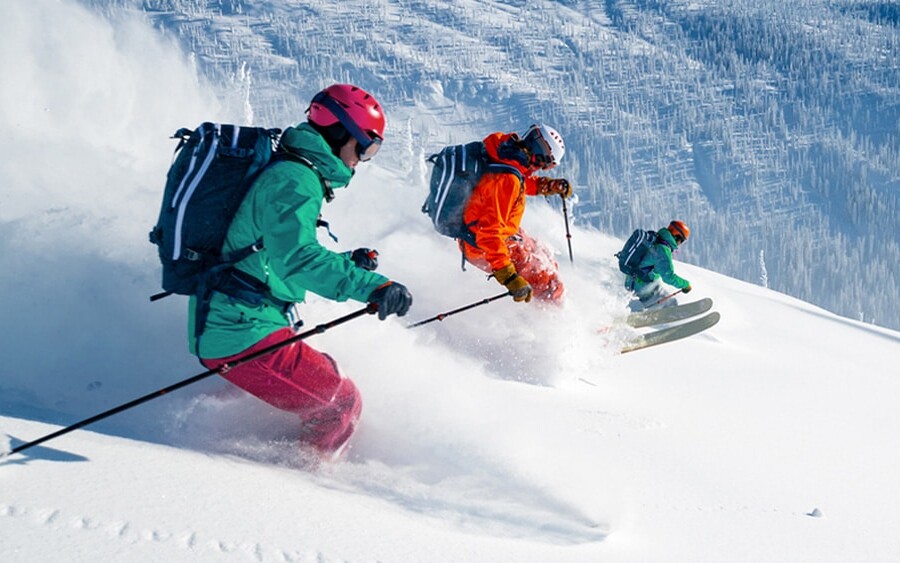Fitness and Performance
How to take your skiing performance to the next level

There is nothing worse than having to hobble in early from the slopes because you’re tired or sore (or even worse, injured). Skiing is much more fun when you’re strong, fit and skiing at your best. So, the more time you put in off the slopes, the better time you’ll have on the slopes. That’s why Bodyset physiotherapist, Ashwini Jadhav is here to share her top tips on how to prep your body for your best snow adventure yet.
“Skiing demands a combination of muscle strength, balance, mobility and cardiovascular stamina to be able to perform well, run after run. Plus, great technique of course! Any preparation you can do in the weeks leading up to your trip will improve your performance as well as reduce your risk of injury. However, I’d advise a minimum of 5-6 weeks training in the lead up to your trip with a focus on hips, knees, core and upper back.” Ashwini
Balance training for skiing performance
Balance is important in all aspects skiing, ensuring better technique and efficiency as well as preventing falls and injuries.
Loaded lateral lunge slides
This exercise replicates dynamic movements used on the slopes, working core, back, and lower limbs. Stand with your feet together and arms straight below you, holding a kettlebell. Take a large step out to the right, immediately lowering into a lunge, sinking your hips back and bending your right knee to track directly in line with your right foot. Keep your left leg straight but not locked, with both feet pointing forward. Push off the right foot to straighten the right leg, step your right foot next to your left, and return to the starting position. Complete reps and repeat on the other side.
How often
2-3 times a week
Sets
3
Reps
10-15 per leg
Weight
Aim to use a moderate weight, using 60-80% of your maximum capability.
Single leg reverse dead lift with weight
Holding a dumbbell in your left hand, stand with both your feet under your hips. Shift your weight to the right leg. Drive your left foot back keeping your leg straight. Simultaneously, slowly start hinging at the waist, tipping your torso forward until it’s almost parallel to the floor. Keep your arms straight, at shoulder height, and perpendicular to the floor at all times. Then, begin pulling your left leg forward while keeping it straight, and lift your torso up until you’re standing again. That’s one rep. Repeat all reps on one side, then switch legs.
How often
2-3 times a week
Sets
3
Reps
10-15 per leg
Weight
Aim to use a moderate weight, using 60-80% of your maximum capability.
Further balance exercises to include in your ski training
Other useful balance exercises could include single leg dynamic balance, single leg standing on a wobble board, star ankle mobility drills, and stability ball glute bridges.
Mobility training for skiing
Mobility training is often overlooked as a key attribute in skiing performance. Improving mobility helps to increase your range of movement and make your body more efficient in activating the correct muscles when skiing. Overall helping to improve your performance and keep fatigue at bay.
Half kneeling hip flexor stretch
When you turn quickly on the slopes you rely on hip and trunk movement. This stretch loosens your hips and prepares your body to move with agility.
Start in a half kneeling posture by placing one knee down directly under the hip and the other foot in line with the knee, creating a 90/90 position. While maintaining an upright posture transfer your weight to the front foot rocking your hips forward. Do not hyperextend your back or dump the hips. Repeat on each leg for 30 seconds.
How often
2-3 times a week.
Quadriceps and trunk stretch
Warming up and easing into movement is important for unlocking your full range of motion in order to prevents injuries, and improve performance by allowing your body to have more control of your lower limbs and trunk during jump landings and sharp turns.
Step forward with your left leg, and lower your body into a lunge. Place your right hand on the floor so it’s even with your left foot. Your right knee should remain above the floor. Move your left elbow inside your left foot, and rest it on the floor. Square your hips so you feel a stretch on both sides, and try to keep your back as flat as possible. Move your left hand outside your left foot, and twist to reach for the sky. Repeat on the other side.
How often
2-3 times a week.
Further mobility exercises to include in your ski training
Other useful mobility exercises could include Bulgarian split squat-quads stretch, hip 90-90 mobility, reverse lunge with twist, cariocas stretch, and thoracic openers against the wall.
Strength and power training for skiing
Skiing requires a strong core and powerful legs. The stronger you are, the longer you can ski for. Stronger muscles also support your joints and absorb more impact when landing jumps.
Lateral box jumps
The quadricep muscles work to help you bend and straighten your knees as you turn, land and increase speed on the slopes. This exercise strengthens your legs and the muscles around your knees and hips, providing better support for your joints and plyometric training for landing jumps on the slopes.
Find a study box or bench that is about 35-60cm off the ground. Stand next to the box, feet hip-width apart. Jump laterally onto the box and land in a squat. Then jump off the box and land on the opposite side. Repeat on the other side. Keep feet hip-width apart and focus on landing as softly as possible on box and floor.
How often
2-3 times a week
Sets
3
Reps
Start with 8-10 and work up to 15.
Side plank
Good core strength is required to sustain postures for prolonged periods, maintain balance and control, and support your back. Ab exercises like planks target the six-pack abdominal muscles in the front of your body. But if you’re wanting to strengthen your core, it’s important to work your obliques too.
Lie on your right side with your legs straight and feet stacked on top of each other. Place your right elbow under your right shoulder with your forearm pointing away from you and your hand balled into a fist. Lift your hips off the mat so that you’re supporting your weight on your elbow and the side of your right foot. Your body should be in a straight line from your ankles to your head. Hold for 15-60 seconds then repeat on your left side. That’s one rep.
How often
2-3 times a week
Sets
3
Reps
3
Further strength and power exercises to include in your ski training
Isometric wall squats with weights, barbel squats, single leg squats, banded trunk twist and lunge, and more.
Cardiovascular training for skiing
To improve your cardiovascular fitness, you should aim to complete a minimum of 150-300 minutes of cardio each week. Over time this will help you develop a strong energy system for maintaining long sessions on the slopes without fatigue.
Swimming, using a static bike, elliptical trainer, rowing machine or treadmill are all great ways to improve your cardiovascular training in the winter months.
Choose an exercise that you enjoy, and the chances are that you’ll be more likely to stick with it!
Circuit training for skiing
For best results combine balance, mobility, strength, power and cardio into a circuit training format 2-3 times a week. Be sure to warm up and cool down with stretches!
“We all underestimate our bodies. On one hand, they are capable of amazing feats, but on the other hand, they are also capable of falling apart before we know it. Taking care of your body for whatever reason is an investment that one will never regret, and seeing a physio to check in on your body is certainly one of those investments…” said British alpine ski racer, Charlie Raposo, following ongoing physio for ski performance.
